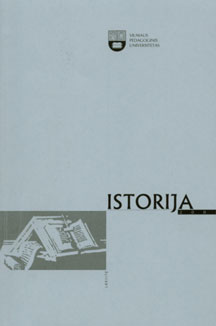Vengrai Lietuvos Didžiojoje Kunigaikštystėje Aleksandro Jogailaičio ir Stepono Batoro laikais (1492–1586 m.)
Hungarians’ Status in the Grand Duchy of Lithuania under the Rule of Jagiello and Stephen Batora (1429–1586)
Author(s): Raimonda RagauskienėSubject(s): History
Published by: Vytauto Didžiojo Universitetas
Keywords: migration; Hungarians; the Grand Duchy of Lithuania in the 16th century; ruler‘s court.
Summary/Abstract: The author of the article concentrates on the issue which was so far overlooked by the historiography, i. e. the status of Hungarians who came to Lithuania in the 16th century. The emphasis is laid on the reasons of their arrival, tendencies of their emigration, and the most eminent personalities who lived at that period. Hungarians lived and worked in the Grand Duchy of Lithuania (GDL) almost throughout the whole 16th century. At least five reasons for their arrival and settlement in the GDL could be distinguished: 1) political situation in the Kingdom of Hungary; 2) the influence of the Reformation movement; 3) the Renaissance cultural movement; 4) economic-trade relations; and 5) possibilities to demonstrate their military art. The GDL was ready to accept newcomers. At the beginning of the century the representatives of Jagiellon dynasty, known to Hungarians, reigned as Kings of Poland and Grand Dukes of Lithuania. Some members of this dynasty, i. e. Sigismund the Old and his daughter Elisabeth, were connected to Hungary by matrimonial ties, and in 1576 the ruler became Stephan Batory, Prince of Transylvania. The courts of both Jagiellos and Batory needed professional craftsmen and elite soldiers. The consumption of Hungarian wine also increased. However, in the 16th century Hungarians comprised only a stable minority, taking up the 5th–6th position after Poles, Germans, Italians, and Czechs. They either stayed in Lithuania for a short period of time or settled there for life, thus choosing Lithuania as their second Motherland. From the social point of view, the noblemen (courtiers or elite soldiers) took up the domineering position though representatives of the lower social layers (craftsmen of different professions, infantrymen, for example) also came to Lithuania. Their status in the courts coincided with their social and professional position. An interesting feature of the Hungarian migration was that it was mostly a male movement. The number of women who came to Lithuania as well as to Poland was low, and they were mainly the rulers’ chambermaids.
Journal: Istorija. Lietuvos aukštųjų mokyklų mokslo darbai
- Issue Year: 72/2008
- Issue No: 4
- Page Range: 21-31
- Page Count: 11
- Language: Lithuanian

